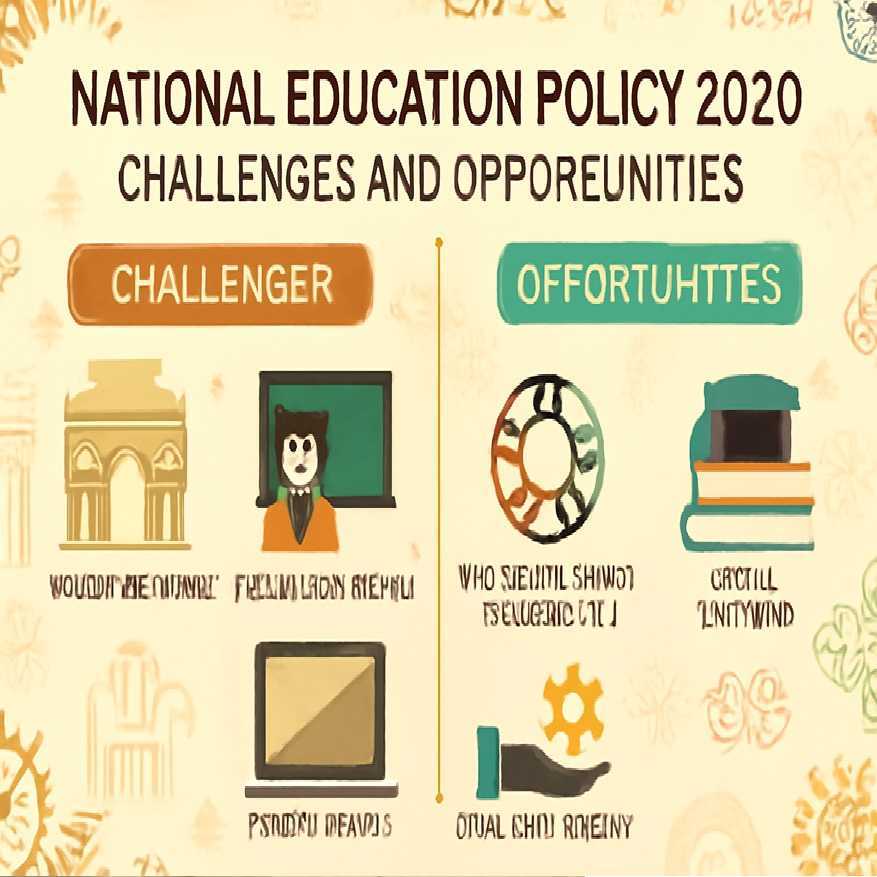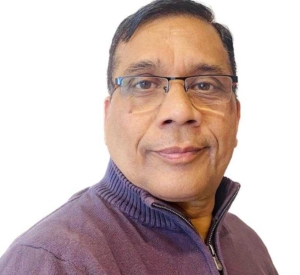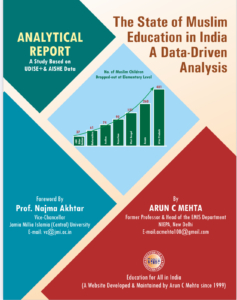
Challenges and Opportunities in Implementing the National Education Policy (NEP) 2020 in Indian Higher Education
Challenges and Opportunities in Implementing the National Education Policy (NEP) 2020 in Indian Higher Education
Introduction
The National Education Policy (NEP) 2020, approved by the Union Cabinet of India on July 29, 2020, represents a landmark reform transforming India’s education system to meet global standards while ensuring inclusivity, equity, and quality. NEP 2020 proposes ambitious goals in higher education, including achieving a 50% Gross Enrolment Ratio (GER) by 2035, promoting multidisciplinary education, fostering research and innovation, and integrating technology through platforms like DIKSHA and PM e-VIDYA. The policy envisions a flexible, student-centric system with initiatives like the Academic Bank of Credits (ABC) and a four-year undergraduate program (FYUP) with multiple entry-exit options. However, implementing these reforms faces challenges such as resource constraints, digital divides, and resistance to structural changes, while offering opportunities to globalize education and align curricula with industry needs. This article examines these challenges and opportunities, evaluates progress from 2020 to 2025, identifies unfinished tasks, and presents data-driven insights using Unified District Information System for Education (UDISE+) trends, as documented on educationforallinindia.com.
Review of Literature
NEP 2020 is lauded for its visionary approach but criticized for implementation hurdles. The Ministry of Education (2020) outlines NEP’s goals for higher education, including multidisciplinary institutions, internationalization, and a single regulator, the Higher Education Commission of India (HECI). The policy emphasizes digital learning, vocational integration, and inclusivity for marginalized groups. Mehta (2023) highlights that despite increased enrollment, achieving universal education by 2030, as envisioned by NEP 2020, remains challenging due to primary and secondary-level inefficiencies, which impact higher education pipelines (source).
Deep and Singh (2022) argue that financial constraints, inadequate infrastructure, and a digital divide – where only 30% of India’s population has smartphone access – hinder NEP’s technology-driven goals. Menon (2020) warns that rapid enrolment growth without funding risks compromising quality. Athavale et al. (2021) note staffing shortages, particularly for students with disabilities, as barriers to inclusivity. Mehta (2022) underscores the role of UDISE+ in tracking progress, noting that data-driven insights are critical for NEP’s success but require robust Educational Management Information Systems (EMIS) (source).
On the opportunity side, NEP’s focus on multi-disciplinary education aligns with global trends, fostering critical thinking and employability. The ABC and multiple entry-exit systems offer flexibility, potentially reducing dropout rates. Mehta (2024) emphasizes AI-driven data management, such as optimizing UDISE+ and SDMS, as a tool to enhance efficiency (source). Internationalization positions India as a knowledge hub through foreign university campuses and global collaborations. Posts on X reflect optimism about curriculum flexibility but highlight persistent infrastructure and faculty shortages.
Progress in Implementing NEP 2020 (2020–2025)
From 2020 to 2025, NEP 2020 implementation in higher education has made strides, though progress varies across objectives:
- Structural Reforms: Over 105 universities, including 19 central institutions, have adopted the FYUP with multiple exit options. The ABC has been introduced, but less than 1% of colleges are registered, indicating slow adoption (Times of India, 2024).
- Multidisciplinary Education: Institutions like IIT Bombay and Delhi University have integrated STEM with humanities, aligning with NEP’s holistic vision.
- Regional Language Inclusion: AICTE-approved programs in regional languages have expanded access, supporting NEP’s multilingualism goal.
- Digital Integration: PM e-VIDYA and DIKSHA have scaled online learning, with MOOCs gaining credit recognition. However, the digital divide limits reach (Mehta, 2024, source).
- Internationalization: IIT-Madras (Zanzibar) and IIT-Delhi (Abu Dhabi) campuses mark progress, with foreign universities encouraged to establish themselves in India.
- Teacher Training: NISHTHA has trained educators, but rural coverage remains limited.
- New Institutions: JNU’s centres for Indian Knowledge Systems (2024) and the upcoming National Digital University (January 2025) reflect NEP’s priorities.
Challenges include delayed HECI legislation, uneven state-level adoption due to linguistic diversity, and insufficient monitoring mechanisms. Mehta (2023) notes that UDISE+ data reveals slow progress toward universal education, impacting higher education enrollment (source).
Evaluation of Progress
Progress is notable but insufficient to meet NEP’s 2035 targets. The FYUP and ABC enhance flexibility, but low ABC adoption reflects logistical gaps. Regional language programs promote inclusivity, yet standardization across India’s linguistic diversity remains challenging. Digital initiatives are promising, but the digital divide restricts access, particularly for rural and marginalized students. Internationalization efforts are underway, but the slow pace of foreign university establishments limits impact. Teacher training programs like NISHTHA are progressing, but rural outreach is inadequate. Mehta (2022) emphasizes that robust EMIS, like UDISE+, is critical for monitoring but requires further strengthening (source). The GER increase from 27.9% (2020–21) to 29.2% (2022–23) is steady but far from the 50% target, requiring significant infrastructure and faculty investments.
Unfinished Tasks
Key tasks remain incomplete as of 2025:
- HECI Establishment: Legislation for a single regulator is pending, delaying streamlined governance.
- GER Target: Achieving 50% GER by 2035 requires 26 million additional enrolments, necessitating massive investments (Mehta, 2023, source).
- Digital Divide: Limited internet and smartphone access hinders e-learning initiatives.
- Teacher Training: Scaling NISHTHA to rural areas is incomplete.
- Monitoring Mechanisms: Standardized metrics for NEP evaluation are lacking, as Mehta (2022, source) noted.
Inclusivity: Infrastructure for students with disabilities and marginalized groups needs enhancement
Trends in Higher Education Enrollment (2012–2023)
The table below, sourced from AISHE data on educationforallinindia.com, shows GER trends in higher education from 2017–18 to 2021–22, reflecting the context for NEP 2020 implementation.
The GER in higher education at the all-India level has shown a steady increase from 24.6 percent in 2017-18 to 28.4 percent in 2021-22.
The GER for males and females has been relatively similar, with a marginal difference in favour of females in recent years, also reflected in the Gender Parity Index.
The overall GER in 2021-22 stands at 28.4 percent, indicating that nearly three out of every ten individuals in the eligible age group are enrolled in higher education in India; this also shows that the remaining 62 percent are not enrolled in higher education. Low participation at this level of education is also reflected in the GER of the SC and ST population analysed below.
Gross Enrolment Ratio at All Indi Level: 2017 18 to 2021-22
|
All Categories |
|||
| Year | Male | Female |
Both |
| 2021-22 | 28.3 | 28.5 | 28.4 |
| 2020-21 | 26.7 | 27.9 | 27.3 |
| 2019-20 | 24.8 | 26.4 | 25.6 |
| 2018-19 | 24.4 | 25.5 | 24.9 |
| 2017-18 | 24.5 | 24.6 | 24.6 |
|
Scheduled Castes |
|||
| Year | Male | Female | Both |
| 2021-22 | 25.8 | 26.0 | 25.9 |
| 2020-21 | 22.4 | 23.9 | 23.1 |
| 2019-20 | 21.5 | 23.2 | 22.3 |
| 2018-19 | 21.4 | 22.8 | 22 |
| 2017-18 | 21 | 21 | 21 |
|
Schedules Tribes |
|||
| Year | Male | Female | Both |
| 2021-22 | 21.4 | 20.9 | 21.2 |
| 2020-21 | 18.8 | 19.1 | 18.9 |
| 2019-20 | 17 | 17 | 17 |
| 2018-19 | 16.7 | 16.1 | 16.4 |
| 2017-18 | 16 | 14.5 | 15.3 |
Source: AISHE different years, Ministry of Education.
Challenges in Implementation
- Resource Constraints: NEP recommends 6% of GDP for education, but budgetary limitations hinder infrastructure and faculty expansion (Mehta, 2023).
- Digital Divide: Limited smartphone and internet access (30% coverage) restricts digital learning initiatives (Mehta, 2024, source).
- Teacher Training: Inadequate training and resistance to new pedagogies limit NEP’s impact.
- Standardization vs. Diversity: Nationwide standardization overlooks regional linguistic and cultural variations.
- Multiple Entry-Exit System: Logistical challenges arise from managing large student populations.
- Privatization Risks: Public-private partnerships may exclude marginalized groups from quality education.
Opportunities in Implementation
- Multidisciplinary Education: Flexible curricula foster critical thinking and employability.
- Internationalization: Foreign university campuses and global collaborations enhance India’s international standing.
- Digital Transformation: Platforms like DIKSHA can bridge access gaps if infrastructure improves (Mehta, 2024, source).
- Vocational Integration: Aligning education with industry needs reduces unemployment.
- Inclusivity: Equity-focused policies promote social justice for marginalized groups.
Concluding Observations
NEP 2020 is a transformative blueprint for Indian higher education, aiming for inclusivity, flexibility, and global competitiveness. Progress from 2020 to 2025, including FYUP adoption, regional language programs, and digital initiatives, is promising but insufficient to meet the 50% GER target by 2035. The GER rose from 27.9% (2020–21) to 29.2% (2022–23), but achieving the target requires 26 million additional enrolments, as highlighted by Mehta (2023). Challenges like the digital divide, resource constraints, and delayed HECI establishment demand urgent action. Leveraging opportunities such as internationalization and AI-driven data management, as emphasized by Mehta (2024), can accelerate progress. Robust EMIS and stakeholder coordination are critical to realizing NEP’s vision of India as a global knowledge superpower.
Suggested Readings
- Deep, A., & Singh, R. (2022). Critical analysis of NEP 2020 implementation challenges. Journal of Educational Policy Studies.
- Menon, S. (2020). Funding issues in higher education under NEP 2020. Indian Education Review.
- Athavale, A., et al. (2021). NEP 2020 and challenges for students with disabilities. Inclusive Education Journal.
- Mehta, A. C. (2022). Decoding UDISE+ 2021-22 enrolment ratios under Samagra Shiksha.
- Mehta, A. C. (2023). School education in India: Where do we stand? Analysis based on UDISEPlus 2023-24.
- Mehta, A. C. (2024). AI-driven educational data management in India: Optimizing SDMS & UDISEPlus.
- Ministry of Education, Government of India. (2020). National Education Policy 2020.
- The Times of India. (2024). NEP 2025: What’s changed and what’s yet to come?
- EY-Parthenon. (2023). Transformation of Indian higher education: Strategies to leapfrog.
- UDISE+ Data. (2023). GER trends in India 2012-13 to 2022-23.


